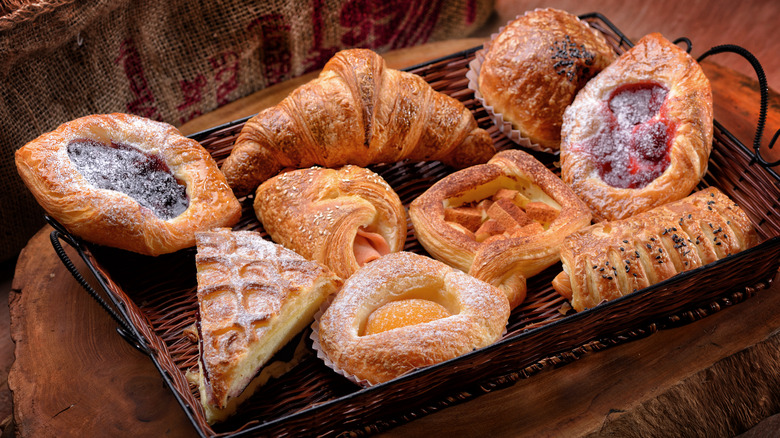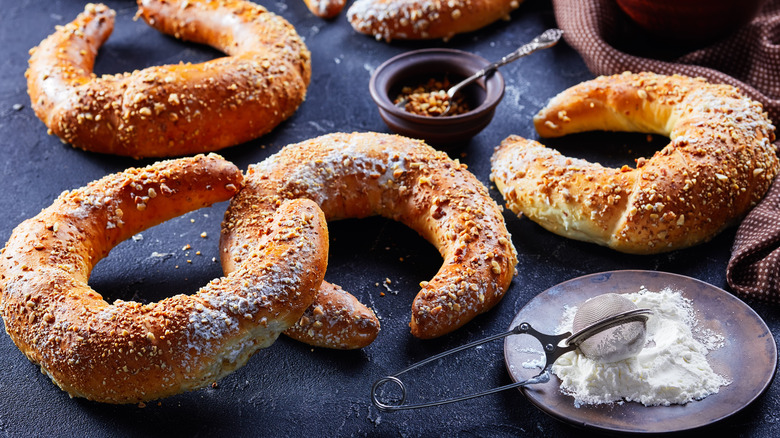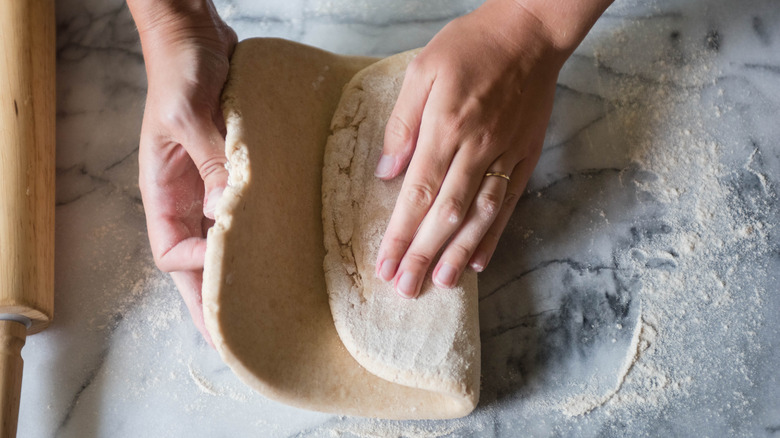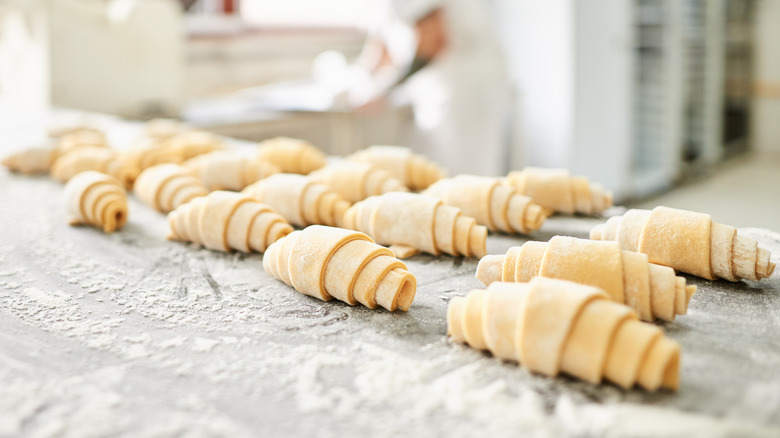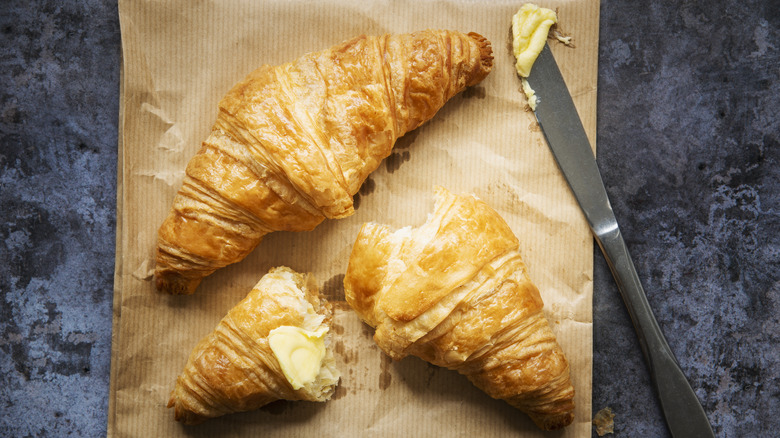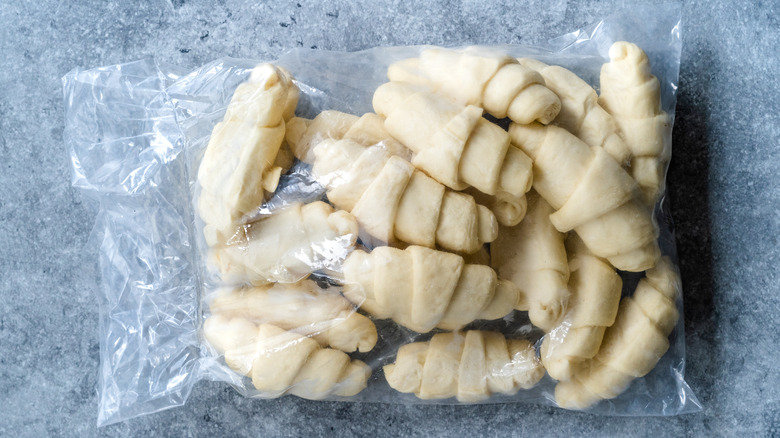Croissant Vs Danish: Everything You Need To Know
When it comes to indulging in sweet, buttery desserts, we are blessed to have several different delectable options: cakes, cookies, donuts, pastries — the list goes on and on. And they come in so many different sizes, colors, and glazes, with a plethora of toppings or fillings. Cream, custard, chocolate, jam, fresh fruit, toasted nuts, and seeds are all utilized.
For those who lack a sweet tooth, savory pastries also exist. That's the beauty of butter and flour. And these savory pastries go with just about everything! From warm slices of ham and melted cheese to roasted tomatoes and herbs to various fruits or jams, many different things can be paired with the flaky layers of a croissant or danish.
Croissants and danishes are two of the most popular pastries in the United States. There are many similarities between them. Whether prepared sweet or savory, either pastry can be enjoyed as a quick breakfast, light lunch, snack, or dessert. But what exactly is the difference between a croissant and a danish? Read on to find out.
The pastries have a shared background
Many people may believe that croissants are from France and danishes are from Denmark. While each pasty is beloved in their respective countries, the treats may have come from a different country altogether. Both treats are actually tied to Austrian pastries.
The croissant descends from the Austrian kipfel, another crescent-shaped pastry made from lard or butter. A kipfel also might also be topped with almonds or sugar, just like a croissant. While a popular legend maintains that the kipfel was invented by a Viennese baker to celebrate the critical defeat of the Ottoman Empire by the Austrians in 1683, this turns out to not be the baked goods' origin. The kipfel was mentioned in a poem written way back in 1227. When the pastry finally arrived in France, however, French bakers made it all their own, and the croissant was born.
The danish — called "Vienna bread" or "wienerbrød" in Denmark — also has a connection to the kipfel. In 1850, Danish bakers went on strike. To keep the bakeries open, Austrian bakers were brought in. Being unfamiliar with Danish baked goods, they made Austrian pastries, including a treat called the Plundergebäck. When Danish bakers began making these Austrian recipes, they tweaked them and made them their own. Thus, the danish came from the Plundergebäck.
Lamination techniques vary
In baking, lamination refers to the process of creating thin layers of dough separated by butter. This is achieved by rolling the dough, placing butter on it, folding it over itself, and repeating these steps. Laminated dough is used in many pastries, including croissants and danishes. However, the processes of lamination used for these pastries differ.
There are multiple ways of folding prepared dough over chilled butter. When making croissants, most bakers use what is called a letter-fold. For this type of fold, the dough is rolled into a rectangle and the butter is rolled into a shorter rectangle. The rectangle is divided into three sections of dough while the dough is folded over itself — and the butter — twice. The process is similar to how a letter is folded before it goes into an envelope.
When making danishes, bakers tend to prefer what is called the book-fold. The dough and butter are rolled out the same as above, except with this fold, the butter is placed in the middle, and the two sides are folded over it to join in the middle. The idea is that it looks like an open book. You then "close the book" by folding the dough in half.
Croissants are crispy, while danishes are flaky
There may not seem to be a big difference between the terms "crispy" and "flaky," but to anyone who has sunk their teeth into these two pastries, the difference is immediately clear. There is a distinct crunching sound that you hear when biting into — or even just pulling apart — a well-made, golden-brown croissant.
It is the thin, even layers of butter between dough that allow the outside of a croissant to become crispy in the oven, while the insides come out soft and buttery. Although danishes are also laminated — giving them very similar layers to croissants — they are softer and less brittle. Their flakiness makes them chewier than croissants, and thus less light, airy, and (of course) crispy.
The fresher the croissant, the crispier it should be. As the pastry sits, humidity gets in and ruins the crunch. Danishes are more moist by design and sometimes made more so when toppings or fillings are added. Luckily, because the crunch isn't important in a danish, they can last another day on the bakery shelf.
Traditional croissants are made without eggs
To anyone with an allergy to eggs, this is very good news! A traditional croissant is egg-free. Just be sure to ask the baker to make certain that the croissants are really free of eggs before indulging. An egg wash may well have been used to make the exterior of the croissant extra golden and crispy. But when making croissants at home, it's easy to leave that step out of the process, for a fully egg-free experience.
The lack of eggs in the dough is one of the key things that sets croissants apart from danishes. Remember, it was supposedly Danish bakers who, after the bakers' strike in the 1850s, took the recipes of the interloping Austrian bakers and added eggs to their pastry dough. This upped the fat content, making danishes more tender and bringing out more of the flavor of the all-important butter.
Both treats come in different shapes
You may not know that the word "croissant" means "crescent." However emblematic the shape is, many have argued that it's a bad shape for croissants. Straight croissants, they say, are the superior shape for the pastry. A straight croissant is easier to pull apart to dunk in coffee.
Croissants are, of course, commonly found in both shapes. Sometimes, the shape can indicate whether the croissant was made with butter (if it's straight) or margarine (if it's crescent-shaped). Chocolate-filled croissants (also known as pain au chocolat) are often shaped more straight, flat, and square than croissants made without fillings.
Danishes, on the other hand, come in quite a variety of shapes. These shapes work to best suit different kinds of danish toppings, from those filled with jam to those topped with solid pieces of fruit. Danishes are often shaped like windmills, envelopes, braids, diamonds, squares, circles, and more.
Danishes have a wider variety of toppings
Don't get us wrong, there is variety in the world of croissants. You commonly find croissants filled with chocolate, almond paste, dulce de leche, and apricots (on the sweet side), and ham or salmon (on the savory side). These are all delicious options. Croissants are also sometimes used to make sandwiches, such as ham and cheese sandwiches, egg and cheese sandwiches, chicken salad sandwiches, and more. However, some may view cutting up a sandwich and using it for sandwich bread as an insult to the pastry itself.
However, part of the reason that danishes have so many different shapes is that each shape has a different use. A pastry that is filled is different from one that has toppings, or a cinnamon danish might be swirled or braided. Just about anything you can think of has probably been paired with a danish. Fresh fruit, pureed fruit, jam, custard, cream, cheese chocolate, icing, powdered sugar, toasted nuts, toasted seeds, and the list goes on and on. Turnovers, folded and stuffed pastries, are also considered a type of danish.
Danishes are baked at a lower temperature
One of the reasons that croissants are so much crispier than danishes is that croissants are generally baked at a higher temperature. The oven is initially set to 400 degrees Fahrenheit, allowing the golden brown crust to form and giving the croissant its signature crunch. But, so as not to over-brown the pastry, you then lower the oven temperature to 350 degrees Fahrenheit, which leaves the inside of the croissant soft and buttery.
When baking danishes, the oven maintains a regular 375 degrees Fahrenheit. At the lower temperature, the pastry rises more slowly. The result of this is the crust of the danish is more flaky and less crispy than that of a croissant. This is a texture that you can really sink your teeth into. Additionally, the toppings are also less likely to burn at this lower temperature. This is ideal because no one wants a danish topped with burned jam.
Croissants and danishes have different nutritional makeups
The differences between croissants and danishes don't end with technique, oven temperature, fillings, toppings, or lack thereof. As similar as the recipes for the laminated dough are, these two pastries are higher in different types of fat. Croissants are higher in saturated fat than danishes, which are higher in monounsaturated and polyunsaturated fats than croissants. What does that mean for your health? Let us explain.
With a croissant, the saturated fat comes from all that butter that goes into the dough. But it's hard to imagine a croissant without it. Butter is what creates those beautiful layers and is a large contributor to a croissant's flavor. Danishes also have saturated fat from the butter used in the lamination process. However, unlike croissants, danishes also contain eggs, which are higher in monounsaturated fat (about 38%) than saturated fat (around 28%). Approximately 16% of the average egg's fat content is also composed of polyunsaturated fat.
Saturated fat is thought to raise LDL cholesterol (the "bad" one), which has been linked to higher risks of stroke and heart disease. Monounsaturated and polyunsaturated fats are the opposite. Consuming more of these two fats can help to lower LDL cholesterol.
We aren't trying to argue that danishes are healthier than croissants, but it is interesting to see the differences. As the saying goes, all things in moderation. But if you are concerned about your cholesterol levels, maybe think of croissants as an occasional treat rather than a daily indulgence.
They should be stored differently
Croissants are best enjoyed fresh, preferably only 30 minutes to an hour after they have been removed from the oven. Humidity is the enemy of crunchiness. If you need to keep your croissant fresh for longer, the best approach is to let it cool, wrap it in aluminum foil, place it inside a bag (paper or plastic is fine), and then put it in a cool, dry, and dark place. If you wrap a cooled, fresh croissant in plastic wrap and then place it inside a bag or airtight container, it can stay good in the refrigerator for about two to four days. For freezer storage for up to one month, you want to wrap the cooled croissants in both plastic wrap and aluminum foil before placing them inside an airtight container. Bring the croissants back to life by popping them in the oven for a few minutes at 200 degrees Fahrenheit.
With danishes, you want to avoid aluminum foil and plastic wrap, both of which could make the danish mushy. Instead, simply store them inside an airtight container. However, when storing them in the refrigerator, use plastic wrap before placing them in an airtight container. Like the croissant, you don't want to keep danishes in the fridge for more than a few days. When freezing danishes, you can follow the same advice as for freezing croissants.
